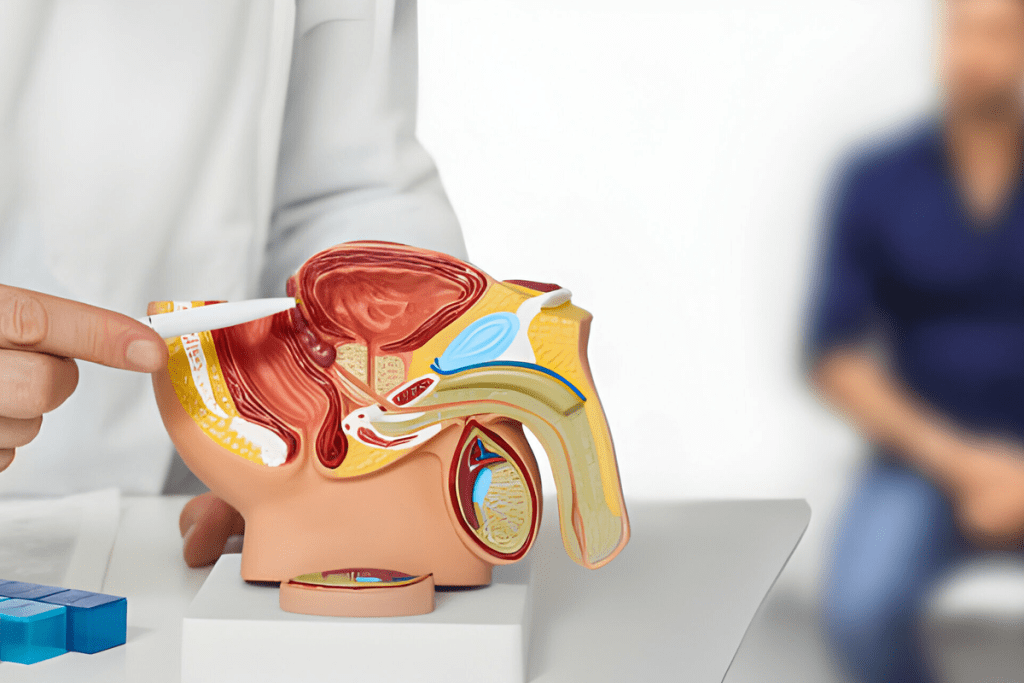Last Updated on October 31, 2025 by
Prostate surgery can save lives, but it comes with big risks. Patients face serious dangers in the weeks after surgery.
Right after surgery, patients are at risk for bleeding, infection, and other serious problems. Studies show that up to 7.5% of patients face complications within 30 days. Bleeding is a big worry on the day of surgery.

It’s key for patients to know about these risks. We’ll look into the details of these dangers and how to avoid them. This way, patients can be ready for their recovery.
It’s important for patients to know about possible complications after prostate surgery. Radical prostatectomy, or the removal of the prostate gland, is a common treatment for prostate cancer. This surgery can lead to several complications.
Radical prostatectomy removes the prostate gland and sometimes nearby lymph nodes. It can be done in different ways, like open, laparoscopic, or robotic-assisted methods. The method used can affect the risk of complications.
Research shows that about 7.5% of patients experience complications within 30 days of surgery. Common issues include:
Some factors can make complications more likely after prostate surgery. These include:
Knowing these risks helps manage patient expectations and outcomes. Healthcare providers can offer personalized care and monitoring to reduce these risks.

Bleeding and infection are big dangers right after prostate surgery. They need careful care after the surgery. These issues can really affect how well you recover and the success of the surgery.
Bleeding on the day of surgery is a big risk, happening in about 3.4% of cases. To lower this risk, a drain system is put in the surgery area. This system removes extra blood and fluid. Careful monitoring of the patient and the drain is key in the first days after surgery.
Wound infections, though rare (1.1% risk), can make recovery harder. Proper wound care and watching for infection signs like redness or fever are key. These steps are important for managing after surgery.
Urinary tract infections (UTIs) are another risk, with a 1.6% chance. To lower this risk, prophylactic antibiotics might be given. Patients are also taught good hygiene habits. Spotting UTI signs like painful urination is important for quick action.
Managing these risks well needs a detailed care plan after surgery. This plan includes medical steps and teaching patients about possible problems and when to get help.

Knowing these risks and taking steps ahead can help patients safely get through the first days after surgery. This way, they can avoid complications like bleeding and infection.
It’s important to know the risks of prostate surgery, like heart and blood clot problems. Prostatectomy, or removing the prostate gland, is a common treatment for prostate cancer. While it’s usually safe, it can cause serious and dangerous complications.
Deep venous thrombosis (DVT) is a big risk after prostate surgery. It’s when a blood clot forms in the deep veins, usually in the legs. If the clot breaks loose and goes to the lungs, it can be deadly. The chance of getting DVT is about 0.7% after prostate surgery.
To lower this risk, patients take anticoagulant medications and move around a lot after surgery.
Heart problems are also a worry after prostate surgery. The surgery stress can make heart issues worse, leading to heart attacks or heart failure. People with heart problems before surgery are more at risk.
Getting a thorough check-up before surgery is key to spotting risks and taking steps to prevent them.
For more info on heart problems after prostate surgery, check out studies in medical journals like PMC.
Having heart or lung problems before surgery makes complications more likely. Patients with heart disease, high blood pressure, or COPD face higher risks. It’s vital for them to get a detailed check-up before surgery and close care after.
By knowing these risks and acting early, doctors can help patients recover better from prostate surgery.
Prostate surgery can change how you urinate and have sex. This is true, even more so for radical prostatectomy. We’ll talk about how it affects your life, from the start to the long-term effects.
Many people face urinary incontinence after prostate surgery. This is because the prostate’s removal can harm nearby muscles and nerves. It’s important to know that these problems are common and recovery times differ.
Right after surgery, a lot of patients struggle with not being able to hold their urine. But most of them get better over time.
How long it takes to get better with urination varies. About 79.6% of patients get better by 12 months after surgery. Knowing this helps doctors and patients plan better.
Prostate surgery also affects sex life. Erectile dysfunction is a common issue due to nerve damage. This can really impact a patient’s happiness and quality of life.
Getting back to normal sexually is a big concern. Studies show that about 36.2% of patients regain sexual function by 12 months after surgery. This shows the challenges and why early support is key.
It’s important to understand these challenges and the recovery process. By knowing the possible side effects, like permanent side effects of prostate removal, doctors can better help patients. This makes the recovery journey easier.
Advances in prostate surgery and care have greatly improved results. At Liv Hospital, we use a team approach and follow international standards. This helps lower the risks of the surgery.
Prostate surgery comes with risks like side effects from removal and complications. But, with new methods, it’s safer now. We stick to strict protocols and best practices to reduce problems. This makes recovery easier for our patients.
We help patients understand the possible complications and how to avoid them. This way, they can face their recovery with confidence. Our goal is to provide top-notch care and support for those having prostate surgery.
Right after prostate surgery, patients face risks like bleeding and infection. They also might have heart or blood clot problems. Knowing these risks helps doctors take better care of patients.
Studies show a 30-day complication rate of up to 7.5% for prostate surgery. This highlights the need for careful patient care and follow-up.
Older patients and those with health issues are more likely to face complications. Also, more complex surgeries carry higher risks.
Bleeding on the day of surgery is a big risk, affecting about 3.4% of patients. Doctors use special techniques and watch patients closely to manage this risk.
About 1.1% of patients get wound infections, and 1.6% get urinary tract infections. Using antibiotics and proper wound care helps prevent these.
The risk of deep venous thrombosis is about 0.7%. Doctors use blood thinners and encourage early movement to reduce this risk.
Right after surgery, some patients may have trouble controlling their urine. But most regain control within a year, with 79.6% doing so by 12 months.
Surgery can affect sexual function, but the impact varies. About 36.2% of patients regain sexual function within a year.
Doctors use blood thinners and encourage early movement to prevent heart and blood clot issues. They also manage existing health conditions carefully.
Patients can lower risks by following post-surgery instructions and attending follow-up visits. Managing health conditions also helps.
A team of healthcare professionals is key in managing risks after prostate surgery. They ensure patients get the best care.
Removing the prostate can lead to long-term issues with urine and sex. But, with the right care and support, these can be managed.
Recovery from prostate surgery can take months. Most patients need about a year to fully recover.
References
Merhe, A., Fares, J., El Koune, R., Halabi, S., Raad, M., Talhouk, R., Abdul-Massih, Y., & Khoury, A. (2020). An evaluation of the timing of surgical complications following radical prostatectomy. Arab Journal of Urology, 18(6), 427-434. PMC+1
Simhal, R. K., et al. (2024). Peri-operative outcomes following radical prostatectomy in a large contemporary cohort. BJU International. 370 BJUI
Paladini, A., and colleagues. (2023). Complications of extraperitoneal robot-assisted radical prostatectomy (eRARP) in high-risk prostate cancer patients: Early and late complication rates. Frontiers in Surgery, 10, Article 1157528. Frontiers
Subscribe to our e-newsletter to stay informed about the latest innovations in the world of health and exclusive offers!